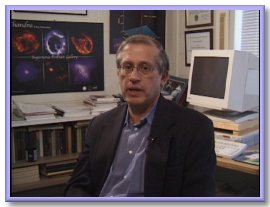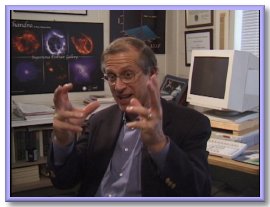H a r v e y T a n a n b a u m
Director
Smithsonian Astrophysical Observatory's Chandra X-ray Center
HT:
"Working on a project like Chandra... starting off, you donít really think that you are going to work on it for 20-25 years. I think you see an opportunity to do something, to be involved in something that has not been done before, and thatís very exciting. And I think we're very lucky when we started working on it that nobody told us it was going to take 25 years. Because perhaps not everybody would have been willing to sign up and sort of hold the course and run the marathon that it really has been.
But, that said, as we were going along and we were making progress on the detectors and the mirrors and as things became closer to reality, it was all very exciting. We were certainly challenged, we were busy all the time. The opportunity now to operate Chandra and have it up in space and working and to see the pictures and spectra that come back each day, that too is very exciting. Chandra is formally scheduled to work for 5 years, but there is a good chance that it will run for 10 to 15 years and I think those of us who are involved will stay involved and excited about doing the science and making sure that those people around the world who are interested in using Chandra have the opportunity to use it."
|
|
|
Launch of Uhuru X-ray Satellite.
|
Tananbaum has been working in X-ray astronomy since his graduate days at MIT. His thesis research was on a mysterious type of cosmic x-ray source. Later, when he was project scientist for the Uhuru X-ray Satellite, observations by the satellite were instrumental in showing that this source was due to matter falling into a black hole. Tananbaum was the scientific program manager for the Einstein Observatory, the first large imaging X-ray telescope. In 1981 he became Associate Director for High Energy Astrophysics at the Harvard-Smithsonian Center for Astrophysics, a position he held for 12 years. In 1991, he was appointed director of the CXC.
P2K:
So what's the point of studying X-ray astronomy? What difference does it make in the real world?
HT:
"Sometimes itís hard to know what all the returns from studying the extremes of physics are. From the point of view of a scientist, of course, we have this thirst for knowledge, we want to know more about the Universe we live in, and for those who are involved in the research, the increase in understanding, the little bit of knowledge that we do gain is of course the primary motivation for what we do.
I think that people in general have curiosity, a certain thirst for understanding what can we learn about our Universe. What is it made of? How big is it? What drives it? If you got very close to a black hole do the laws of physics change? ...We donít have a mechanism whereby we can make a black hole down here on the EarthÖ and thatís probably for the best that we canít do that! But when there are black holes out there on the sky and we can look at them and study what happens very close to the black hole--and X-rays are the most powerful probe we have for looking close to the surface or event horizon around that black hole--then we may find that what space and time look like very near a black hole are not exactly what we expect and Einsteinís theory of general relativity, the underlying laws of nature, the things which characterize the Universe that we live in, might change again.
To say what the practical implications are at this point is, at least for me, not possible. But I think understanding where things are... and where they might be different is very important. It is important to understand this vast Universe in which we live and thatís the primary purpose of the things we do."
Tananbaum received the NASA Exceptional Scientific Achievement Medal in 1980, and the NASA Public Service Award in 1988. He is a fellow of the American Association for the Advancement of Science, and has served as vice-president of the American Astronomical Society, as well as on numerous NASA advisory committees.
|


